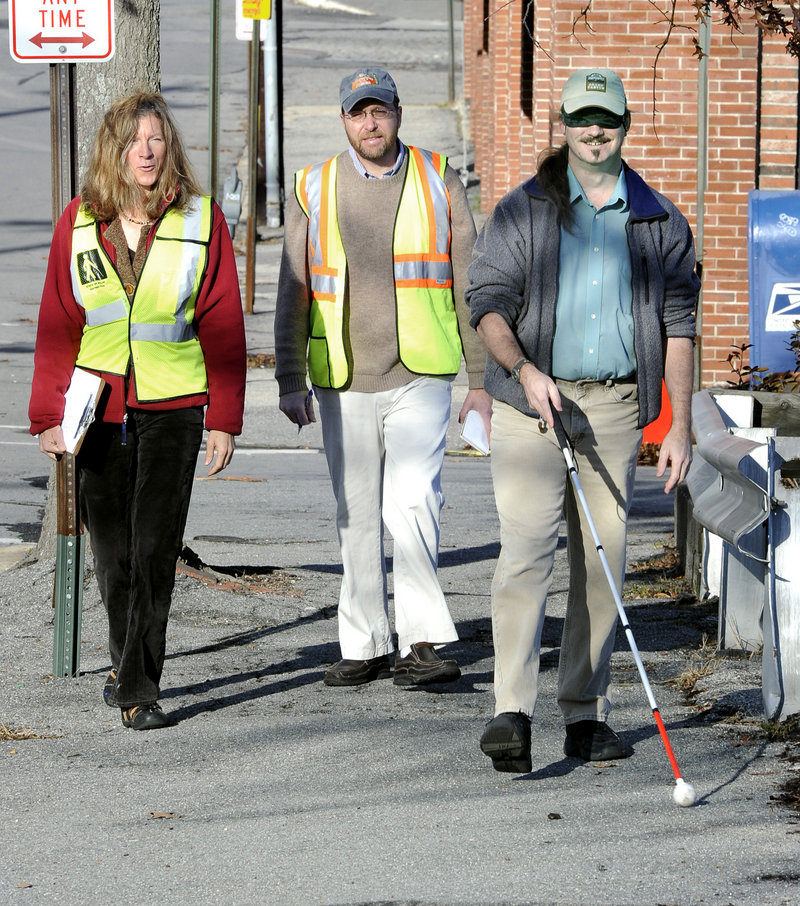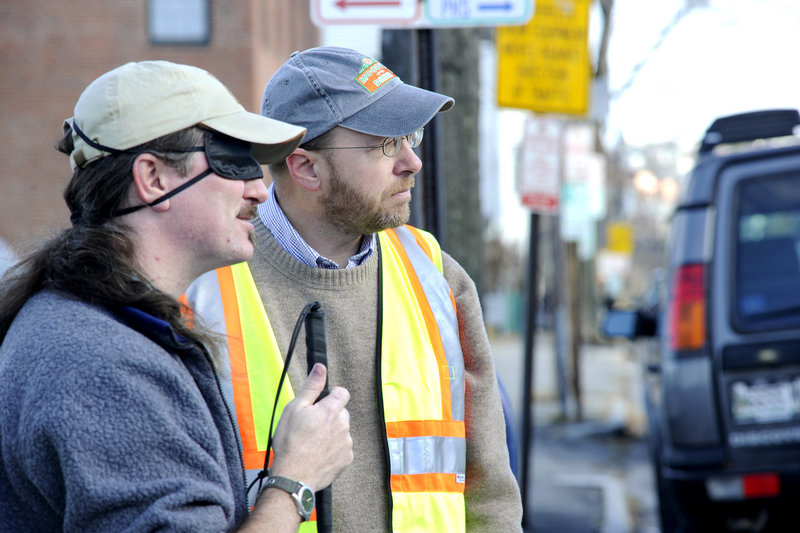PORTLAND – Using a cane to guide himself, Wayne Lawson walked along the sidewalk on Lancaster Street toward the busy intersection with Elm Street.
I walked a good five feet behind him, as I had been instructed to do by Caitlyn Blodget, an orientation and mobility instructor with the Maine Department of Labor’s Division for the Blind and Visually Impaired.
Blodget has been working with Lawson for months, teaching him the strategies and methods he needs to navigate sidewalks, streets and intersections on his own. For the moment, she wanted to give Lawson some space and see how well he was learning to use the cane as a navigational tool.
Once Lawson found his way to the corner — by the slope of the sidewalk cut and the sound of traffic he knew he was at the corner — he positioned himself to cross Lancaster. But before he could do that, Blodget asked him a series of questions to help him analyze his situation.
“What do you hear?” Blodget asked.
“I don’t hear any traffic right now, it’s quiet,” Lawson replied.
“What about masking noises, do you hear any of those?” Blodget asked.
“I hear the rope of a flagpole flapping. I hear some noise coming from (a nearby manufacturer),” said Lawson, 43, of Portland.
“So if you’re at a quiet spot, with masking noise, is that the best place to cross?” Blodget asked.
Lawson knew the answer. So we all waited for the noise of traffic.
Blodget explained that when crossing parallel to a busy street, one of the safest ways to cross is to wait until you can hear a surge of traffic on that street. Specifically, listen to make sure cars sound like they have enough momentum to go past you, that they aren’t turning into the street you’re crossing.
Lawson was curious about drivers slowing down to turn right on a red light. What is the best way to prepare for that?
“You get your cane out there, you get where they can see you, and if everything else is right, you go. It’s a leap of faith. Crossing any street is a leap of faith,” said Blodget.
Lawson didn’t feel confident about crossing at most of the street corners we came to, so Blodget guided him across. Part of the reason, she said, was that using his cane as a guide hadn’t yet become second nature to Lawson.
Lawson is not totally blind. He experiences ocular migraines, which trigger long periods of blindness and make it nearly impossible for him to see at night, or in bright light. His condition is getting worse, but there are times when his sight is good, so he doesn’t use his cane all the time.
As he practiced with Blodget, he wore a sleep shade to make sure he could not see.
Blodget decided that for most of her hourlong session with Lawson on this day, she would guide him across intersections and have him focus on analyzing sounds and traffic patterns while at corners. Lawson, while not completely trusting his hearing, appeared adept at identifying pedestrians, bicyclists and other noises that would affect a crossing.
As we walked around downtown Portland, Blodget let me guide Lawson for a while. She said it is important not to physically pull or push a visually impaired person along. The best way is let them hang on to you, then tell them whatever they need to know to walk with you safely.
So I held my left elbow close to my side and let Lawson grab it. Then I began to walk slowly down Preble Street. I quickly noticed there was a valve head of some kind sticking up from the sidewalk in Lawson’s path. I moved to my right so he could avoid it, but had to duck my head to avoid being bonked by a no-parking sign.
A few minutes later, I told Lawson to stop so I could kick a fallen branch out of his way.
When helping Lawson cross Elm Street, I had to crane my neck around a telephone pole to see oncoming traffic. But I didn’t want to step out in the street to see, for fear that Lawson would start walking with me.
While guiding Lawson wasn’t too difficult, I could tell that being able to teach a blind person how to cross a street safely takes a lot of training.
Blodget, 43, has been doing this work for 10 years and has a master’s degree in blindness rehabilitation from the Pennsylvania College of Optometry. She said her training included wearing a sleep shade and analyzing traffic conditions just as Lawson was doing. She said it takes a year or more for many visually impaired people to get comfortable with crossing streets.
I got a sense of how long crossing the street can take for a visually impaired person while walking with Lawson and Blodget.
At busy intersections with traffic lights, Blodget often told Lawson to “wait another cycle” of lights if conditions weren’t as predictable as possible.
If there were no sounds from traffic, wait another cycle. If drivers were slowing down nearby, possibly because they saw you and weren’t sure what you were going to do, wait another cycle.
“What I love about this job is that I can deliver tools that can completely change their lives and let them be free,” said Blodget. “And I get to come along for the ride.”
Staff Writer Ray Routhier can be contacted at 791-6454 or at:
rrouthier@pressherald.com
Send questions/comments to the editors.




